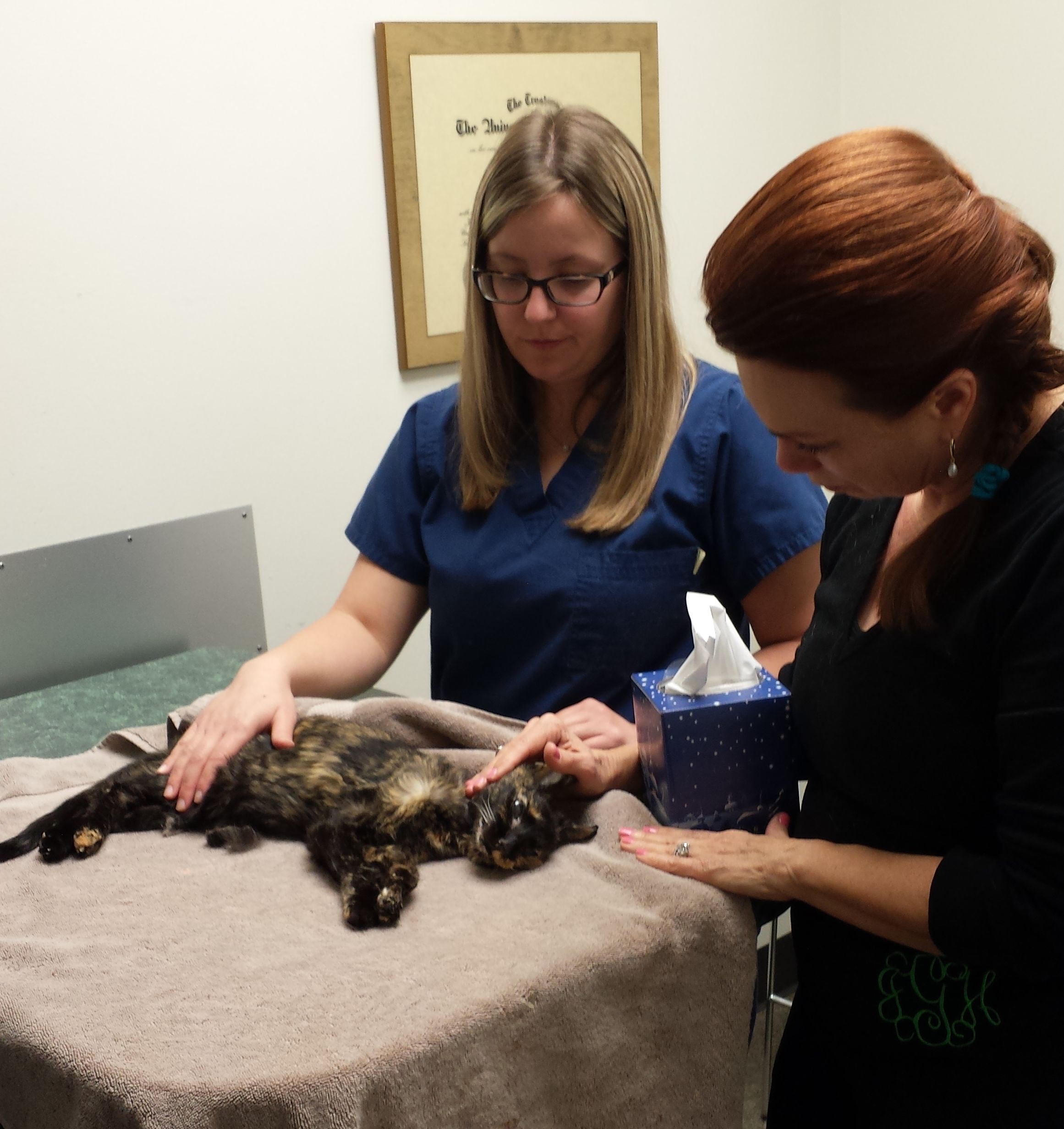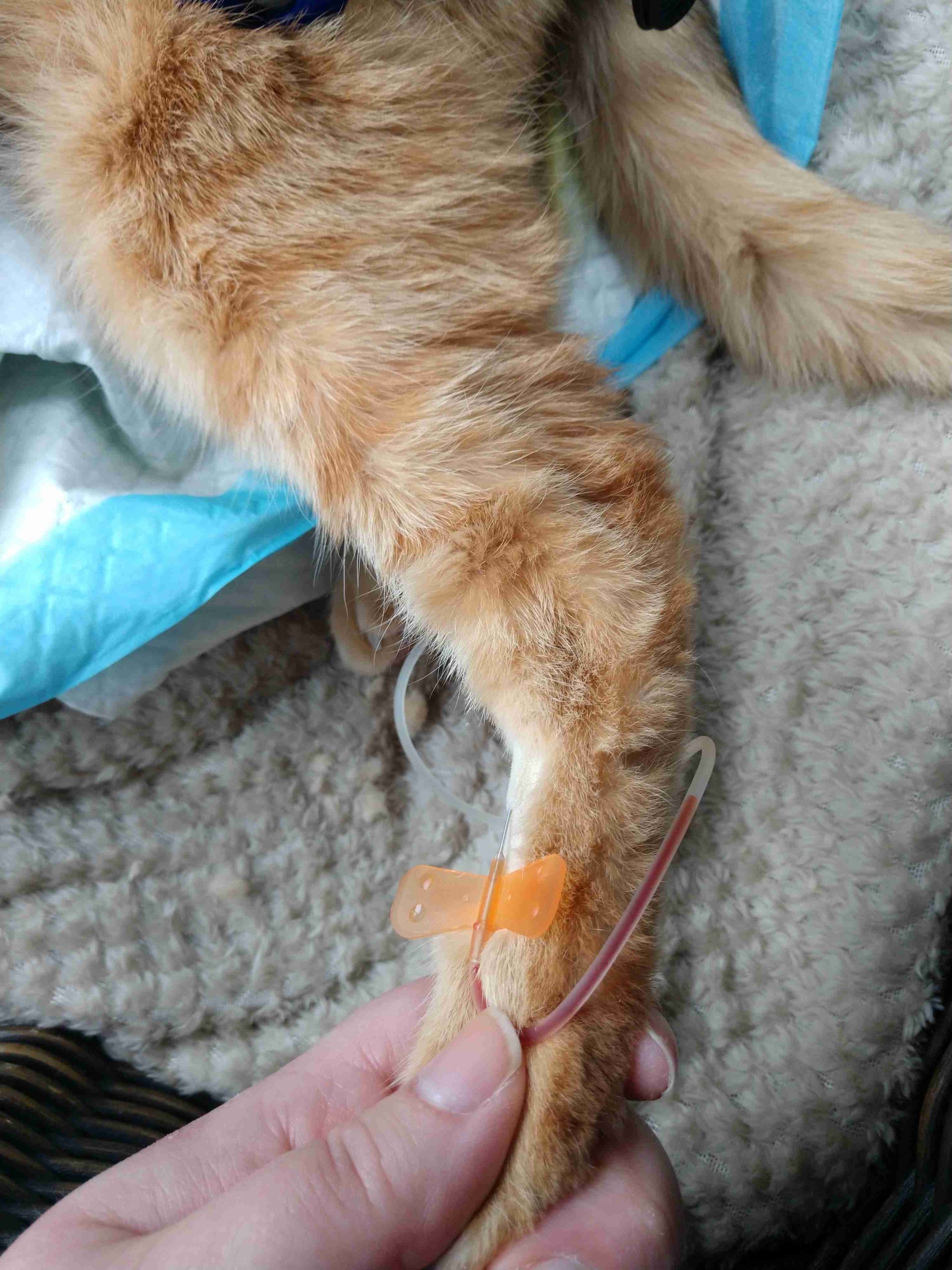The euthanasia appointment is the last opportunity a veterinarian has to serve a patient and the caregivers directly. With planning, the appointment can go very well. Preparation begins with being familiar with available euthanasia techniques, and by obtaining and organizing the supplies associated with the multi-step procedure.
Preparation

- In both the home and the hospital setting, veterinarians should ensure they have the appropriate medications used for pre-euthanasia sedation/anesthesia and euthanasia.
- Equipment needed includes various sizes of syringes (1cc, 3cc, 5cc, 10cc) and needles (27g, 25g, 22g, 21g, 18g).
- Needle gauge and length size will vary depending on the euthanasia technique used. A quiet cordless rechargeable clipper can come in handy.
- Additional supplies include:
- Non-alcoholic hand sanitizer that can be used to wet the fur to help visualize the vein
- Stethoscope to confirm the heart has stopped
- Tourniquet to place proximal to the chosen intravenous (IV) site
- Be transparent with the process. Explain and prepare caregivers about each step of the process, and inform them when you start each step. Just as you narrate your examination, narrate the euthanasia process, so the caregiver knows what to expect.
- It is best to explain, in very basic terms, the sedatives that will be administered, and which euthanasia technique will be used.
- To avoid confusing or upsetting caregivers, do mention that you might need to change the euthanasia technique during the procedure.
- For some clients, it can be very upsetting when their cat’s eyes don’t close, either after the cat is sedated or after the cat has died. Informing them of this before you begin with the sedation may impact the way they decide to hold their cat during the process.
- Since urination and defecation are common perimortem changes, it is good practice to place a waterproof pad under the patient before you administer medications.
Sedation
When at all possible, the cat and the caregiver should not be separated after their arrival at the veterinary practice. Separating the cat from the owner causes tremendous stress and anxiety for both the cat and the owner. Using other options besides an IV catheter for administering the euthanasia solution, such as a butterfly catheter for intravenous access, or another route from the techniques listed below, will provide a more comforting experience for all, whenever possible. If a patient must be taken to another room in the practice, it is best to ask the client for permission and to explain the reason for needing the take the cat from the room.
- Deep sedation or anesthesia is preferred to ensure the cat is fully asleep prior to administering the final injection. Sedation minimizes fear, anxiety, and pain; lessens the need for restraint; allows for closeness with caregivers; and can lessen unwanted side effects of the administration of euthanasia solutions.
- Whatever combination of drugs is used, the patient should be completely unaware of their surroundings and unresponsive to all stimuli.
- Subcutaneous injections using very small gauge needles are recommended to minimize stimulating the patient. Remember that some cats may be in chronic pain, and they may be hyperalgesic and/or hyperactive.
- The goal is to prevent our patients from feeling pain.
Popular pre-euthanasia sedation techniques combine an anxiolytic medication like benzodiazepines with phenothiazines, and then with or without the addition of an opioid.
Table: Pre-sedation Protocols (Download table)
| Drug Combination Protocols IM or SQ Administration | Body Weight in Kilograms | |
| < 4.5 kg (10 lbs) | 4.5-9.0 kg (10-19 lbs) | |
| Ketamine 100 mg/ml | 0.1 ml | 0.15 ml |
| Acepromazine 10 mg/ml | 0.1 ml | 0.15 ml |
| Tiletamine-Zolazepam 100 mg/ml | 0.2 ml | 0.3 ml |
| Ketamine 100 mg/ml | 0.3 ml | 0.4 ml |
| Butorphanol 10 mg/ml | 0.3 ml | 0.4 ml |
| Acepromazine 10 mg/ml | 0.1 ml | 0.1 ml |
| Midazolam 5 mg/ml | 0.3 ml | 0.4 ml |
| Tiletamine-Zolazepam 100 mg/ml reconstituted with the following: | 0.2 ml | 0.3 ml |
| 2.5 ml of Acepromazine 10 mg/ml and 2.5 ml of Ketamine 100 mg/ml | ||
| Tiletamine-Zolazepam 100 mg/ml reconstituted with the following: | 0.1 ml | 0.2 ml |
| 5 ml of Acepromazine 10 mg/ml | ||
| Dexmedetomidine 100 mcg/ml | 10 mcg/kg | |
| Ketamine 100 mg/ml | 1-2 mg/kg | |
| Butorphanol 10 mg/ml * | 0.4 mg/kg | |
| Drug Combination Protocols for IV Administration | Body Weight in Kilograms | |
| < 4.5 kg (10 lbs) | 4.5-9.0 kg (10-19 lbs) | |
| Propofol 10 mg/ml ** | 8-12 mg/ml | |
For additional information and guidance on administering /anesthesia, please see the AAFP Feline Anesthesia Guidelines.
Euthanasia Administration
Euthanasia solutions used for domestic animals are barbiturate solutions or barbiturate-combination solutions.

- Barbiturate solutions are approved for all methods of administration.
- Combination barbiturate solutions (e.g., pentobarbital and phenytoin sodium) are not approved for intraperitoneal (IP) injections.
- Euthanasia should never be attempted with inadequate amounts of euthanasia solution on hand.
- The euthanasia technique using the smallest amount of euthanasia solution is the IV method (1 ml/4.5 kg [10 lbs]).
End-of-life patients can be very debilitated, making IV venipuncture very challenging. End-of-life practitioners should familiarize themselves with approved euthanasia techniques so they can confidently approach each euthanasia appointment. These techniques include:
Intrarenal (IR) Technique
- The dose is 3 ml/4.5 kg (10 lbs) of euthanasia solution.
- The IR route of administration is well suited for cats and is the route recommended by the FelineVMA.
- It works very well when loved ones are near and when vein access is difficult.
- Caregivers can hold their cats as they pass, honoring the human-animal bond.
- Respiratory and cardiac arrest occurs quickly (less than 30 seconds). Death typically occurs within one minute when the injection is properly positioned in the renal cortex or medullary tissue.
- The left kidney is located outside of the retroperitoneal space and is usually easier to locate than the right.
- This technique does require that the patient is unconscious, so /anesthesia is required.
- Disadvantage: the small kidney size in patients suffering from chronic kidney disease can make this a challenging technique, and there is the possibility of confusing fecal balls or abdominal masses for a kidney. Also, an improperly positioned injection can prolong death, taking as long as 15 minutes. This technique requires a larger volume of euthanasia solution, so it is imperative that enough solution is on hand.
Intravenous (IV) Technique

- The standard dose used is 1 ml/4.5 kg (10 lbs) of euthanasia solution, but patients who have circulatory compromise should be given 2 ml/4.5 kg (10 lbs).
- Used in the relaxed cat.
- Solution is injected steadily and will cause complete lack of consciousness in approximately five seconds with deep anesthesia in approximately ten seconds.
- Cardiac standstill will occur within approximately 40 seconds but depends on factors like circulation times, etc.
- Many practitioners can use a well-placed butterfly catheter so that the cat does not have to be removed from the room for IV catheter placement.
- The cephalic and medial saphenous veins are the veins most commonly used.
- Sedation should be given prior to administration.
- Disadvantage: the cat’s medical condition and relative size can make locating and accessing a vein challenging, and may not be possible with smaller cats. The veterinarian must possess good venipuncture skills to perform the IV technique.
Intrahepatic (IH) Technique
- The dose is 2 ml/4.5 kg (10 lbs) of euthanasia solution.
- The patient needs to be unconscious, so /anesthesia is required.
- Death occurs in approximately two minutes.
- The liver is right up against the diaphragm and takes up half of the caudal ribcage space. The needle is placed on either side of the xiphoid notch aiming up under the rib and towards the head in a laterally recumbent patient.
- Disadvantage: inadequate penetration of the liver will slow the time from administration to death to as long as ten minutes. To avoid this, the veterinarian should use an adequate needle length. One-inch (1”) needles are used for most cats. When this technique is used, caregivers should be told it can take as long as ten minutes for the patient to pass.
Intraperitoneal (IP) Technique
- The dose is 3 ml/4.5 kg (10 lbs) of euthanasia solution.
- The IP technique is an easy technique to master.
- Injections are given along the midline caudal to the umbilicus or low on the right lateral abdomen.
- Use ¾” or 1” needles to avoid penetrating abdominal organs.
- Patients should be anesthetized.
- Respiration should cease in approximately six minutes with cessation of heartbeat at approximately eight minutes.
- Disadvantage: this technique requires a larger volume of euthanasia solution, so it is imperative that enough solution is on hand. The presence of abdominal fluid or low blood pressure can significantly slow the absorption of the euthanasia solution, so proper patient selection is required for this technique to provide the desired result.
Intracardiac (IC) Technique
- The dose is 1 ml/4.5 kg (10 lbs) of euthanasia solution.
- The IC route is often used when vein access is a challenge or when an immediate death with little preparation is desired.
- It is mandatory that the patient should be completely unconscious when this method is chosen, so /anesthesia is required.
- A stethoscope is used (this is something you can feel as well) to find the point of maximum intensity of the heart sounds. This is typically at the fourth intercostal space in line with the shoulder on the left and at the fourth intercostal space in line with the elbow on the right.
- The syringe is held perpendicular to the body wall when it is inserted. If a rib is encountered accidentally, gently redirect the needle as it is inserted.
- It is important to use a syringe large enough to hold the appropriate amount of euthanasia solution and accommodate aspiration of blood to ensure proper placement of the needle before injection of the euthanasia solution.
- Disadvantage: most caregivers will be uncomfortable with this technique, so if this technique is chosen, it is best to discuss why this method is best for the patient.
When the euthanasia procedure is planned with care and consideration for the cat to be euthanized, the outcome should be a peaceful and pain-free transition. The caregivers that are present for the procedure should be fully informed and aware of the steps that will be followed. Though you want death to come quickly and gently, you want there to be enough time for everything the caregiver(s) and the team needs. Lastly, you want those that have experienced the loss to know where to go if they need support. Bereavement and grief counseling services can be found in the Client Resources section of this Toolkit.
Additional information can be found under Further Reading.
